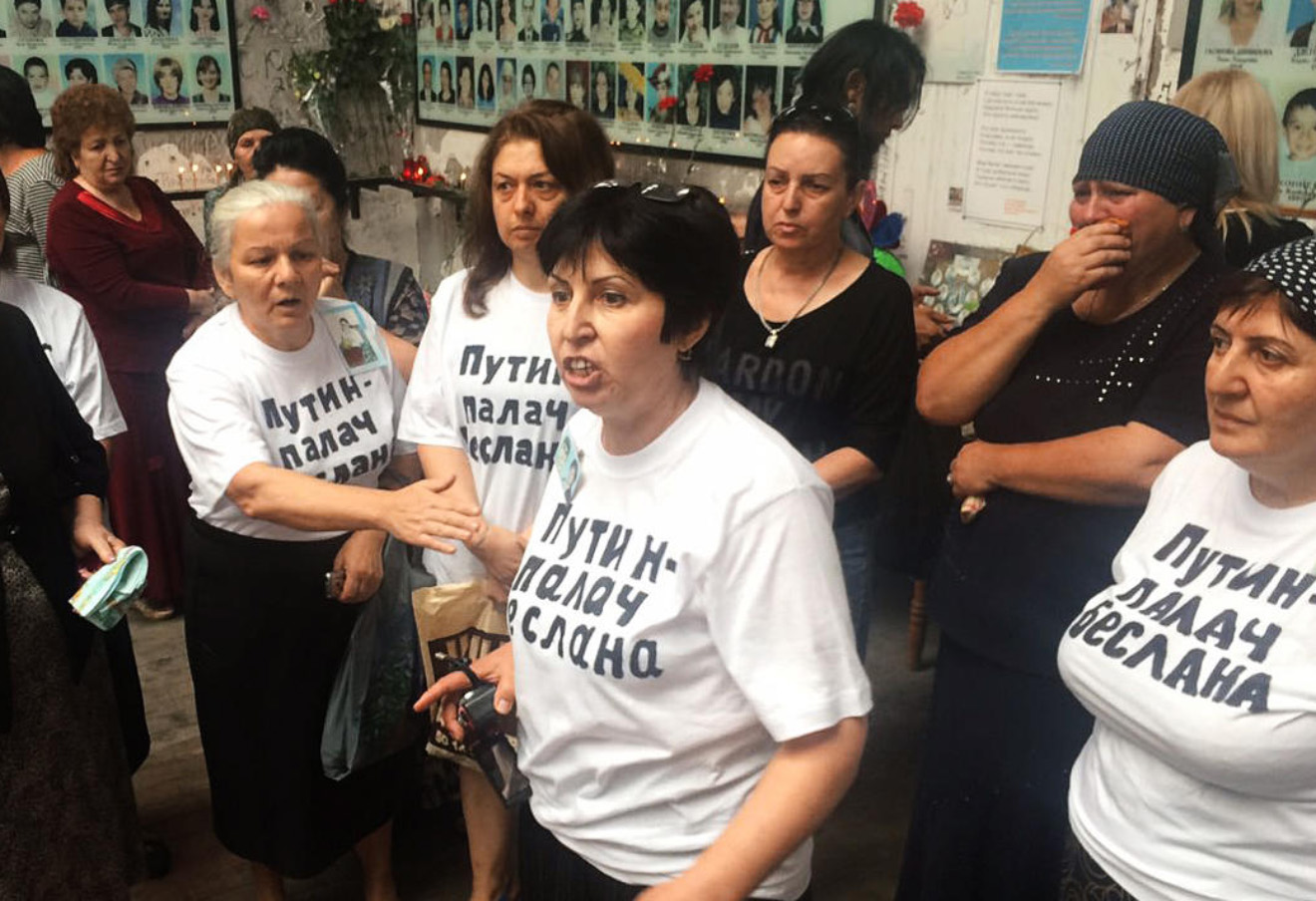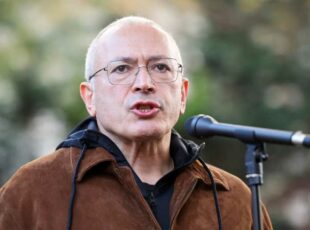The Executioner of Beslan
On September 1, 2016, five grieving activists from the Voice of Beslan movement attended a commemoration ceremony at School No. 1. And then they were arrested …

Photo: Diana Khachataryan
Sergey Orlov
They were all dressed in t-shirts inscribed with the words “Putin is the Executioner of Beslan.” Their children were killed on this very spot in September 2004 (the Beslan siege claimed the lives of 334 people, 186 of them minors), but, even twelve years on, an objective and transparent investigation isn’t forthcoming, so the women have been forced to demand one. Which is precisely what they were doing.
Afterwards, the mothers went to the cemetery. On their way there, however, they were rounded up, forcibly taken into custody, charged with violating the rules regarding the holding of pickets and rallies, and, in a final humiliation, sentenced to fines and compulsory community service.
To help you make up your own minds about whether or not these women have a moral right to denounce Putin, we’ll tell you their respective stories:
ELLA KESAYEVA (head of Voice of Beslan). Lost two nephews and her son-in-law during the siege, but her daughter Zarina survived. Sentenced to 20 hours of compulsory community service in September 2016.
The arrest left her with extensive bruising on her arms. Two men in military fatigues bundled her into a waiting vehicle, she recalls, and many others – “including the district police chief” – pushed her towards it. “We left the school at around noon, and as soon as we’d reached the nearest building, we were accosted by what must’ve been a good hundred police officers, OMON personnel, people in civilian clothing. They joined hands and formed several circles around us. I was the first to be grabbed…”
Though not among the hostages in September 2004, Ella Kesayeva endured what was arguably no less harrowing an ordeal: “Around one o’clock [on 03.09.2004], there was a tank outside the Dzagoevs’ house, with a few soldiers – around five of them – behind it. And then the tank opened fire. The windows of the school building just started exploding. I began to scream: ‘Jesus God, they’ve got tanks firing on children!’ But it just kept on firing.”
Yuri Savelyev, a leading weapons and explosives expert who has authored an independent report on the Beslan siege, maintains that over fifty Beslan residents saw three tanks firing on the school – in broad daylight: “An unpalatable fact alluded to by many witnesses and hostages is that shots were fired on the façade of the canteen even though hostages – women and children – had been forced to stand on the window sills, where they were waving various pieces of fabric.”
Let us remind our readers of the official version of events, which holds that tanks fired on the school only on the evening of September 3, by which time the last of the terrorists were being flushed out of the basement and the building was empty of hostages.
ZHANNA TSIRIKHOVA. Held hostage together with her two daughters, one of whom, eight-year-old Elizaveta, was killed. Fined 20,000 roubles in September 2016.
Zhanna, too, emphasises the brutality with which the women were apprehended: “When we refused [to write explanatory statements or go to the police station], they grabbed us […] and bundled us roughly into waiting vehicles. One woman was punched, we’ve bruises on our arms.”
Zhanna goes on to describe the terror of 2004: “On the third day [of the siege], around lunchtime, I heard this whistling and hissing, and then an explosion went off … the children had been on my lap, but suddenly they were gone. I found my elder daughter. Her sister, Liza, was lying nearby with her head smashed in…”
As Yury Savelyev takes care to stress, the Geneva Convention prohibits the use of indiscriminate weapons – i.e., weapons that leave no chance of survival. But precisely such weapons were deployed at Beslan by FSB Special Operations Centre personnel, and namely rocket-propelled flamethrowers, rocket-propelled grenade launchers, and assault grenades.
The official version, meanwhile, holds that no indiscriminate weapons were deployed while there were still hostages in the school building. The authorities deny that the operation to free the hostages was launched after special forces operatives used a grenade launcher they’d set up on the roof of a neighbouring house to fire on the sports hall.
SVETLANA MARGIEVA. Held hostage together with her daughter, twelve-year-old Elvira, who was killed. Sentenced to twenty hours of community service in September 2016.
Svetlana, the oldest of the women, experienced the most brutal treatment: “I was hit on the head and began to vomit. They were dragging us into their vehicles, we didn’t want to go. We were driven to the police station against our will and detained there for five hours before being taken to the courthouse. They didn’t even give us any water. We’d been taken hostage by law enforcement. The trial went on until four in the morning.”
During the siege, Svetlana suffered wounds to the leg and abdomen, but this is by no means what will remain forever etched in her memory: “When I came to after the explosions […], I saw that there was someone lying in my arms. I recognised her by her clothes. It was my daughter. Then I looked at her face. Her eyes were open, there was blood coming from her throat, and her jaw was slack. She’d died in my arms.”
The authorities insist on the following version of events: an improvised explosive device made by terrorists exploded in the sports hall, prompting the hostages to flee, whereupon the extremists opened fire – thereby leaving special forces operatives with no choice but to storm the school. According to the unofficial version, however, the catalyst for the premature operation was the potential imminent arrival in Beslan of Chechen leader Aslan Maskhadov: if the latter were to secure the hostages’ release following negotiations with the terrorists, Putin would suffer an inadmissible political defeat …
EMMA BETROZOVA. Lost her husband and two sons – Alan, 16, and Aslan, 14 – during the siege. Sentenced in September 2016 to a 20,000-rouble fine.
Emma’s husband demanded that the terrorists give the children some water. He wasn’t spared: “My husband Ruslan was killed […] before the eyes of our sons, and they didn’t allow his body to be removed from the sports hall for twenty-four hours afterward. My poor boys survived their dad by just a single day. I recognised my eldest by the sock on his foot.”
And although the authorities lay the blame for the death of the hostages solely at the door of the terrorists, Emma Betrozova – along with many others in Beslan – begs to differ: “I believe the blame lies with the government, with the authorities: they’re to blame because they failed to save our children, and because they created the conditions that made the terrorist act possible in the first place.”
EMILIA BZAROVA. Lost her nine-year-old son, Aslan, during the siege; the cause of his death was impossible to determine due to the charring of his body. Sentenced in September 2016 to twenty hours of community service.
Emilia Bzarova no longer believes that the Russian authorities are possessed of even the slightest degree of integrity or conscientiousness; over the years, she’s seen far too many things that prove otherwise: “I just can’t get my head round the vandalism that followed in the wake of our tragedy at School No. 1. They destroyed everything. They destroyed the building fired on by the tank, eradicated all traces of the crime […], and, using God to their advantage, went on to set up a shrine.”
Although the authorities have done their utmost to suppress any information about the storming of the southern wing of the school, where over a hundred hostages were killed, Yuri Savelyev not only managed to establish the minutiae of what happened, but also to ascertain how incriminating evidence was subsequently destroyed: “Late in the evening [of 03.09.2004], classrooms and a workshop located in the school’s southern wing [which had survived the storming operation. – Ed.] were destroyed by flamethrowers and high-explosive tank shells […] before being flooded with water from hydrants. Mountains of debris were taken to landfill throughout the night and the following morning – and all in the presence of Ministry of Emergency Situations [Sergei] Shoigu, who had arrived on the scene. Beslan residents would subsequently uncover human fragments at the landfill site, together with the hostages’ personal effects.”
It must also be noted that the investigation of the school as a crime scene lasted a mere eleven hours. In the immediate aftermath of the siege, the authorities were intent on demolishing the entire school complex, but were prevented from doing so by the dead children’s mothers, who threatened to lie under the bulldozers.
ZEMFIRA TSIRIKHOVA, too, was sentenced to twenty hours of community service. And although Zemfira, who lost her younger son during the siege, wasn’t involved in the rally, the court nonetheless found sufficient grounds for sentencing – she’d committed the grievous offences of “being in a group of women” and “allowing herself to make remarks.”
Without the sieges of Nord-Ost and Beslan, one could argue that there would have been no Crimea and no Donbas. The current regime has ventured ever further down the road of unbridled licence, ridding itself of all constraints of law and morality. When it finally departs the scene, official investigations will need to be launched into every phase of “Putin’s Progress,” from Nord-Ost to Eastern Ukraine. For as long as society remains ignorant of the truth behind these events, we shall never succeed in making the breakthrough to a new Russia.



